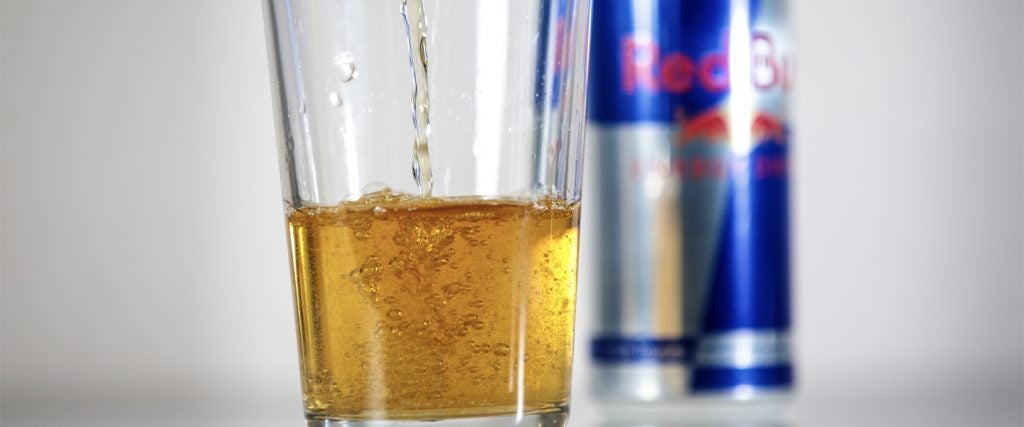It’s shocking to think that the term “energy drink” was once commonly used to define the sports drink market exemplified by Gatorade. All such definitions changed seemingly overnight as Red Bull and other highly caffeinated beverages took the U.S. by storm, beginning with clubs and bars before rapidly spreading to every gas station, convenience store and grocery store in the country.
Due in part to Red Bull’s vaunted potency, it was besieged by rumors that its most invigorating ingredients were freshly plucked from a bull’s testicles. Specifically, what was presumed to be the most potent contributor to Red Bull’s energy-gifting formula — the taurine — was said to be collected from either bull semen, bull urine or both. Furthermore, as Red Bull was the first major energy drink to attract a rabid following throughout Europe and the U.S., it established how an energy drink should look and function for all the imitators that would follow.
And certainly, the fact that the very first energy drinks — including most energy drink companies’ flagship beverages — looked almost identical to urine did nothing to halt the rumor that their core components originate in the testicular regions of bulls.
Why is it that the basic color of the original energy drinks looks so unappetizing?
The urine-like appearance of Red Bull and its contemporaries is something that immediately caught the attention of its earliest reviewers in the American media.
Red Bull first landed on the radars of most Americans in October 1994 thanks to an article by Arthur Allen of the Associated Press. Reporting from Germany, Allen wrote about a “sports drink” that had gained more of that market within Germany than Gatorade, and that was advertised to “improve muscle tone,” “increase endurance by 25 percent” and “invigorate mind and body.”
“It’s right on the border of the drug scene,” department store clerk Guido Hoffman told Allen after his small shop sold 500 cans of Red Bull in a single month. “Otherwise, tell me why someone would spend two marks ($1.20) for a little can of it.”
When Red Bull ultimately reached the U.S., its edginess and predicted placement on the banned-substances list was routinely mentioned in the coverage surrounding it. Ryan Igbanol wrote of Red Bull’s beer-like appearance and equivalent (if opposite) capability for the Orlando Sentinel in 1998, while questioning Red Bull’s potential to remain viable in the marketplace. “If it proves to be as state-altering as it seemed in my experience, it could only be a matter of time before the FDA puts Red Bull on its list of banned substances,” Igbanol predicted.
In a 2000 piece from the Minneapolis Star Tribune, Jon Tevlin reported the entire urine-balls rumor double whammy, getting official Red Bull spokesperson Emmy Cortes to admit that the allegations of the beverage’s bovine testicular origin played a role in Red Bull’s blistering pace in attracting new customers, while one of those customers commented on the coloring. “Red Bull looks exactly like urine, and it tastes like Smarties,” they explained.
Okay, but who decided it should look that way?
Red Bull’s roots originate with Chaleo Yoovidhya, a Thai businessman of ethnic Chinese descent. He started TC Pharmaceuticals in Thailand in the 1960s, and introduced Krating Daeng — a non-carbonated tonic beverage with caffeine, taurine, inositol and B-vitamins — to the Thai marketplace in 1976.
Six years into the bottled energy drink’s admitted underperformance with Thai consumers, Austrian businessman Dietrich Mateschitz tried Krating Daeng and was impressed by its ability to alleviate his jet lag. Mateschitz sought out Yoovidhya for a partnership, and the eventual result of that partnership was the 1987 launch of Red Bull, which was a carbonated version of Krating Daeng featuring much of the same branding and modified for Western tastes.
Even as a carbonated, Westernized equivalent to a Thai tonic beverage was being popularized, tonic consumption remained commonplace all over Asia at the time. As just one example of this, an Associated Press article from 1988 spoke of a Japanese tonic bar called The Energy Pool, which sold more than 180 such varieties. Many of them were advertised to contain exotic ingredients like cobra extract or essence of seal — fantastical components that sound suspiciously on the level of bull urine — but the most common and potent stimulant in most of the drinks was simply caffeine.
Got it. So the urine coloring is all Yoovidhya’s fault.
I would honestly attribute it to the idea that the color wasn’t considered to be a turnoff in the tonic marketplace in the era that spawned Red Bull, and Mateschitz decided that there was nothing broken about the color that was in need of fixing before he introduced it to Western consumers.
By the way, taurine received its name because German scientists successfully isolated and extracted it from the bile of an ox in 1827, and not from the balls of a bull. So let that be a lesson to you: If enough people become bullish about your exotic new beverage, you’ll probably be left to contend with a sea of rumors and slander — like how your drink is made out of bull piss. But if there’s anything to be learned from Red Bull’s example, just because people are spreading rumors about you, that doesn’t mean you can’t ride that wave of bullshit to billions of dollars in profits.

